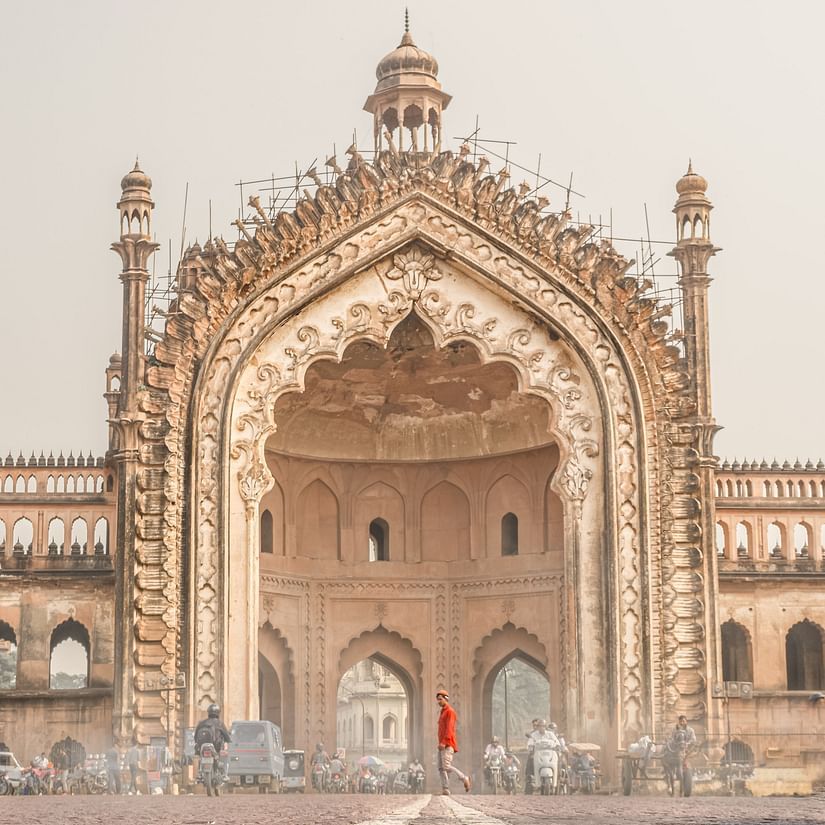Arching gracefully over Hussainabad Trust Road in Lajpat Nagar, Rumi Darwaza is one of the oldest and most famous structures of the city. At first glance, the unassuming daily crowds and the occasional roadblocks shroud the true significance of this iconic building. But it stands, strong and ever-so imposing, beating the test of time and modernisation. This majestic gateway speaks volumes of the heritage and ancestry of the locale. In every sense of the word, Rumi Darwaza is a gateway to Old Lucknow.
The history of Rumi Darwaza, Lucknow dates back 238 years when it was built in 1784, at the behest of the then Nawab of Awadh - Asaf-ud-Daula. Following the death of his father in 1775, he became the nawab at the young age of 26. Raised under the shadow of his mother and grandmother, the famous Begums of Oudh who amassed wealth and administrative power with the help of the British, Asaf-ud-Daula wanted to break away and build his own empire. Lucknow was, at that time, just a small town.
His plan to elevate this lesser-known town into a stately capital that rivalled the princely Islamic cities of the time, was the start of its ascension to glory. Designed by the Persian architect Kifayatullah, Rumi Darwaza was built to surpass the Sublime Porte, Bab-iHümayun in Turkey and clearly reflects the love and regard that nawab Asaf held for art and culture.
The history of Rumi Darwaza, Lucknow dates back 238 years when it was built in 1784, at the behest of the then Nawab of Awadh - Asaf-ud-Daula. Following the death of his father in 1775, he became the nawab at the young age of 26. Raised under the shadow of his mother and grandmother, the famous Begums of Oudh who amassed wealth and administrative power with the help of the British, Asaf-ud-Daula wanted to break away and build his own empire. Lucknow was, at that time, just a small town.
His plan to elevate this lesser-known town into a stately capital that rivalled the princely Islamic cities of the time, was the start of its ascension to glory. Designed by the Persian architect Kifayatullah, Rumi Darwaza was built to surpass the Sublime Porte, Bab-iHümayun in Turkey and clearly reflects the love and regard that nawab Asaf held for art and culture.

There is another interesting story behind the completion of Rumi Darwaza (also spelt Rumi Darwaja in several instances). The Kingdom of Awadh was struck by famine during his rule. Being the proud citizens they were, people refused to accept help from the royal treasury for free. So Asaf-ud-Daula launched a food-for-work programme, which meant surplus labour for the expansion of the up-and-coming city, as well as a source of income in a famine-ridden time. He was renowned as a wise and generous leader.
The design, which resembles Mughal, Roman and Turkish styles, later became famous as Awadhi or Lakhnawi architecture. It distinctly strays away from red sandstone, that had become a telling feature of Mughal architecture. In its prime years, the intricate carvings of the flower buds that adorn its archway squirted water. And the topmost framework - the octagonal chhatri or umbrella-shaped dome, was illuminated by a huge lantern.
The 60 ft tall gateway was established as the entrance of the newly-created capital city - Lucknow, to current readers - Old Lucknow. Now, it stands as a testament to the glories of Awadh, slightly withered, yet all the more graceful.
If you are visiting The City of Nawabs, then Rumi Darwaza cannot be missed. A stay at Clarks Avadh - a regal 5-star hotel in Lucknow, is the best way to ensure that your stay is a grand and unforgettable affair, just like our heritage structure.
The design, which resembles Mughal, Roman and Turkish styles, later became famous as Awadhi or Lakhnawi architecture. It distinctly strays away from red sandstone, that had become a telling feature of Mughal architecture. In its prime years, the intricate carvings of the flower buds that adorn its archway squirted water. And the topmost framework - the octagonal chhatri or umbrella-shaped dome, was illuminated by a huge lantern.
The 60 ft tall gateway was established as the entrance of the newly-created capital city - Lucknow, to current readers - Old Lucknow. Now, it stands as a testament to the glories of Awadh, slightly withered, yet all the more graceful.
If you are visiting The City of Nawabs, then Rumi Darwaza cannot be missed. A stay at Clarks Avadh - a regal 5-star hotel in Lucknow, is the best way to ensure that your stay is a grand and unforgettable affair, just like our heritage structure.